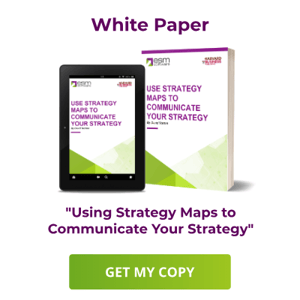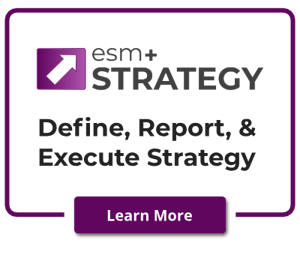Want to Design A Strategy that Your Employees will Understand? Build a Strategy Map.
Introduction To a Strategy Map
Most organizations do a good job identifying key objectives/goals for growth. Some organizations take the next step and articulate them in the form of a written strategy with measures. Though, few organizations follow a disciplined approach to ensure the strategy is implemented and communicated — where real value is created for the organization. The Strategy Map should be in your arsenal to achieve strategy execution and breakthrough results.
 Over the years, the Strategy Map has evolved to address many of the prerequisites that contribute to successful strategy execution – articulation and communication. While comprehensive, some might say that the Strategy Map has added complexity to the strategic planning approach. In our experience, the strategy mapping process is super simple when a simple and disciplined creation approach is followed. Things get complex when the strategist and leadership team over-develop the Strategy Map and thus, make it a challenge to implement.
Over the years, the Strategy Map has evolved to address many of the prerequisites that contribute to successful strategy execution – articulation and communication. While comprehensive, some might say that the Strategy Map has added complexity to the strategic planning approach. In our experience, the strategy mapping process is super simple when a simple and disciplined creation approach is followed. Things get complex when the strategist and leadership team over-develop the Strategy Map and thus, make it a challenge to implement.
The longer-term risk of an overbuilt strategy is that the audience “tunes out” and loses the core message. Avoid trying to pack too much on the map and diluting the most important areas of focus. We address this challenge through a four step Strategy Map creation process that helps you effectively design and communicate a simple strategy.
“Sweating” the strategy as a collective team is one of the most powerful ways to create cohesion and unification at the senior level and is key to ensure there is “one version of the truth” come implementation and communication. Be sure to collaborate with key stakeholders and leaders to ensure everyone’s voice is heard.
Four steps to create The Strategy Map
A Strategy Map is a graphical representation of the strategy with objectives that are aligned across four core business perspectives: Financial; Customer; Internal and Talent and Technology. We encourage you to tackle each perspective one by one to efficiently define your map.
Step 1. Articulate the Financial Perspective: The first step in the Strategy Mapping process is to define the organization’s financial model. The financial model typically includes three measurable objectives including Revenue Growth, Cost Management/Reduction and Return.

These three objectives, or variations of them, can be used for most private sector organizations. Public and/or Mission Driven organizations often include a purpose-related objective that captures the organization’s mission. Keep the financial perspective simple and clean. This perspective is the most generic perspective and there’s no need to get too fancy here.
Step 2. Define the Customer Perspective: Important to any strategy is the recognition of strategic and non-strategic customers and their differentiated value proposition. In step 2 you want to first clarify and define target customers who will be impacted by the strategy. The output in this step will include two to four key value proposition statements and one core customer objective.
The value proposition defines what the customer wants and subsequently that which the company must provide to be strategically successful. At the highest organizational level it is useful to consider both current and future strategic customers in the mix and identify a shared value proposition. We often tell our clients to capture the customer value proposition through the lens of these customers to reinforce the reasons why you have customers. For example, put the objective in the first person: “Give me high quality solutions,” or “Be my trusted advisor.”
Following the value proposition, you want to brainstorm the one key customer objective that best encapsulates the value proposition. For example: “Enhance Customer Loyalty” or “Diversify the Customer Base.” Selecting more than one customer objective puts at risk the loss of focus on the most important customer objective and can weigh down the Strategy Map.
Step 3. Build out the Internal Process Perspective: The desired financial and customer outcomes of the Strategy Map are now known. Steps one and two clarified this so now we turn to the inner workings of the organization and identify how to optimally get work done, be it deliver the service, build the product, or provide the experience. The internal process perspective states what is required to deliver the customer and financial objectives.

The role of the internal process perspective has evolved considerably over the past 30 years of implementation, moving from complexity to simplicity. Step three should only include the critical/necessary objectives, grouped by thematic areas. We think of themes as general areas of focus that contain related objectives. The internal process perspective is increasingly focused and simplified when first defining the themes.
Optimally, the internal perspective will include three or four strategic themes the organization must do well to produce the desired strategic outcomes. Common theme examples include: Innovation, Operational Excellence, Community and Environment.
Within each strategic theme, brainstorm one or two objectives that capture the critical work needed to deliver each theme. The focus should be on process improvement objectives. Examples include “Digitize our Customer Marketing Funnel” or “Drive Innovation around Machine Optimization.”
Step 4. Identify the Talent and Technology: Often referred to as the intangible objectives  required to support the work of the internal process objectives. In this perspective, talent is defined as the skills and knowledge of the workforce; technology, known as the information management tools to support the strategic work; and the organization’s culture that permits full potential of the human assets to be realized. It is recommended that for each of the three intangibles assets, one relevant objective be defined and included on the Strategy Map. Identify areas for the greatest growth, such as “Hire for the Key Strategic Roles” or “Build a Culture of Inclusiveness.”
required to support the work of the internal process objectives. In this perspective, talent is defined as the skills and knowledge of the workforce; technology, known as the information management tools to support the strategic work; and the organization’s culture that permits full potential of the human assets to be realized. It is recommended that for each of the three intangibles assets, one relevant objective be defined and included on the Strategy Map. Identify areas for the greatest growth, such as “Hire for the Key Strategic Roles” or “Build a Culture of Inclusiveness.”
Your Strategy Map is now built. If an inclusive process is followed in the above steps, by-in to the strategy should already be in place.
The Strategy Map Should Tell Your Organization’s Unique Story
When done right, the Strategy Map serves two purposes: it identifies the critical few objectives needed to execute the strategy and it arranges the objectives across four business perspectives in a way that tells the story of the strategy.
 Some organizations get creative with visual images to enhance their Strategy Map. We’ve had clients add pictures of each objective sponsor/advocate next to their objective or layer in a background image of a traditional looking bank or hospital with various parts of the building representing each perspective. We also see clients use flow chart arrows to communicate the cause-and-effect logic between objectives and perspectives. Once your Strategy Map is built, practice talking through “the story of your strategy.” Clients will most often tell the story from the Talent and Technology Perspective, and move up through each subsequent perspective. Ultimately, you should be able to say that if you have the right people with the right technology and right culture, you will be able to execute the Internal Perspective, deliver to your customer’s expectations, and finally, achieve your desired financial results.
Some organizations get creative with visual images to enhance their Strategy Map. We’ve had clients add pictures of each objective sponsor/advocate next to their objective or layer in a background image of a traditional looking bank or hospital with various parts of the building representing each perspective. We also see clients use flow chart arrows to communicate the cause-and-effect logic between objectives and perspectives. Once your Strategy Map is built, practice talking through “the story of your strategy.” Clients will most often tell the story from the Talent and Technology Perspective, and move up through each subsequent perspective. Ultimately, you should be able to say that if you have the right people with the right technology and right culture, you will be able to execute the Internal Perspective, deliver to your customer’s expectations, and finally, achieve your desired financial results.
At the end of the day, you want to personalize the Strategy Map to fit your culture so that it serves as a communication device that explains the strategy. Make it the poster that hangs on the wall or the real-time monitor in your company’s lobby with performance status colors to communicate performance and drive engagement.
Be sure to download our 20 Strategy Map Templates to help you get started with building your own Strategy Map today.






